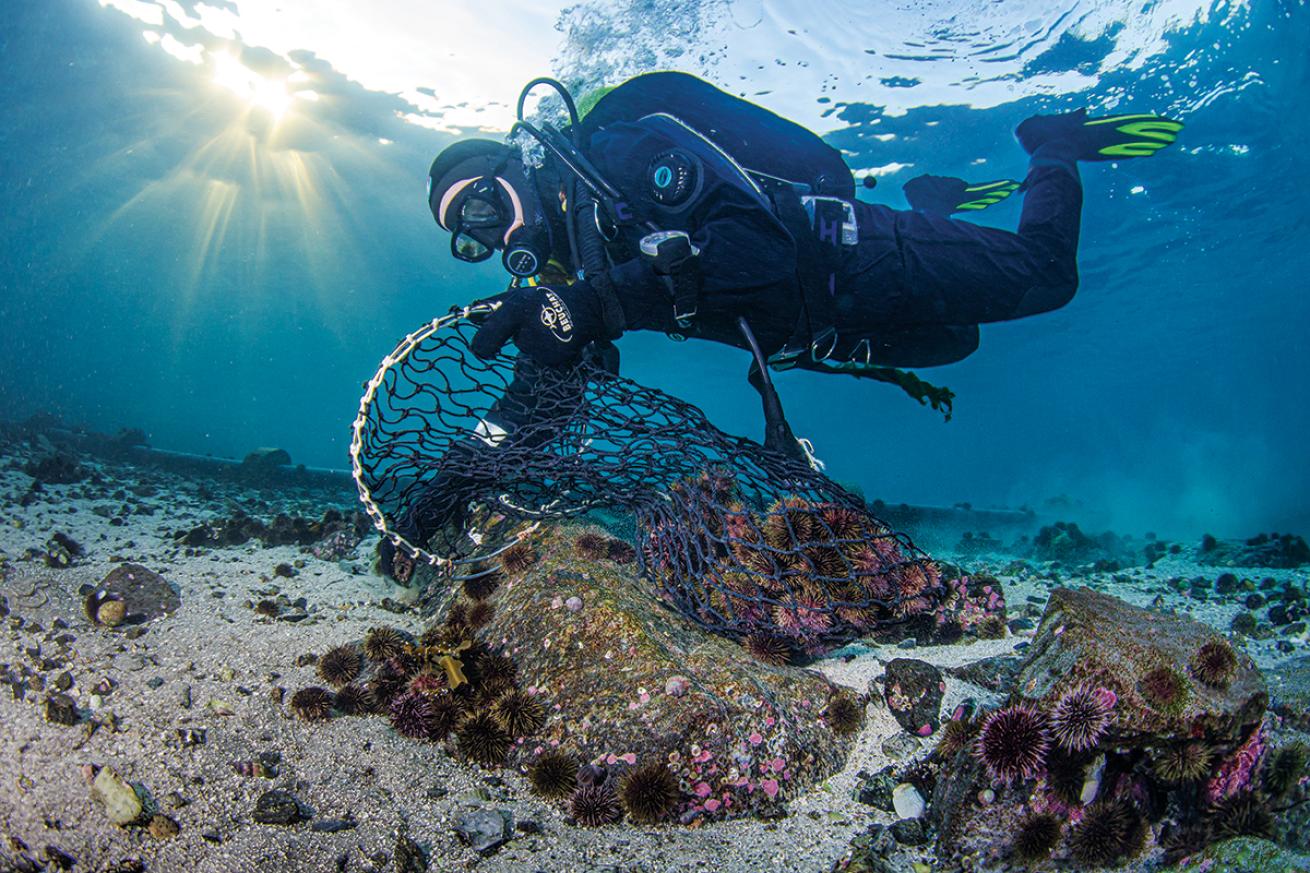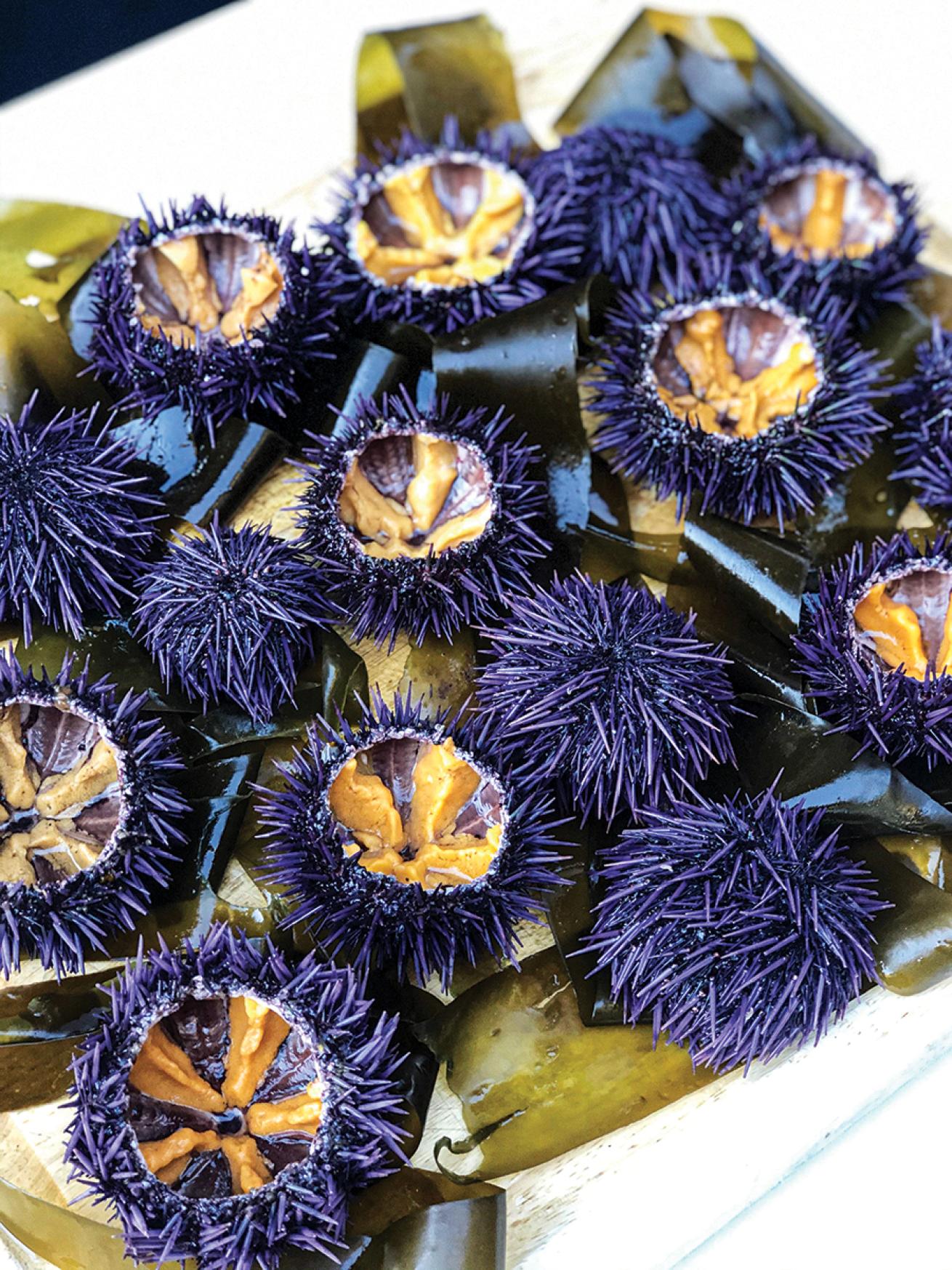Meet the Company Creating Sushi that Heals the Ocean

UrchinomicsA diver collects urchins from a barren stretch of seabed.
When the 2011 tsunami struck Japan, the topside damage was easy to see: more than 400,000 homes were destroyed, and over 23,000 people died or went missing.
Its underwater devastation took longer to spot. Just as the wave battered human neighborhoods, it blasted apart marine communities. Larger species moved out like refugees and, with few predators left, purple urchins proliferated. They wiped out kelp beds and, with them, hope of large fish returning and a powerful carbon sink.
As local fishermen tried to get back to work, says Brian Tsuyoshi Takeda, they found “rebuilding was in a weird way the easier part because the insurance covered the house and the boats...but when they got back to the sea to get back to their living, the fish were gone.” And they would remain absent as long as the urchin barrens persisted.
Such barrens can be found all across the world, in part thanks to overfishing. “There’s a strong correlation between industrial, intensive fishing and urchin barrens,” Takeda, an entrepreneur living in Norway, says. “You can’t take a whole slice out of the ecosystem and think everything’s gonna be okay.”
But he sees an unexpectedly elegant solution to the purple urchin global takeover: harvesting their gonads.
Known in the culinary world as uni, urchin gonads are an exclusive sushi ingredient wildly popular in Japan and around the world. At first, it is easy to think urchin proliferation would be a boon for uni devotees. But as purple urchins mow down verdant kelp forests, they cut off their own food source. A starving urchin’s gonads shrivel, no longer edible.
Enter Urchinomics, Takeda’s urchin ranching company, which hires commercial divers to clear purple urchin barrens. Many of these wild-caught urchins are then raised in specially designed tanks until their roe is large enough to sell to restaurants. The business’ first commercial cultivation facility came online in Japan this year, where several ventures have served its uni. A third party dive nonprofit, Mobile Sea Otters, will monitor the sites near the ranch to gauge the restoration impact.
“We can remove overgrazing urchins and turn them into a luxury seafood product, help restore kelp forests, encourage fish and marine biodiversity, sequester CO2 and create meaningful full-time jobs in rural communities whilst providing profitable opportunities for those communities and partners,” says Takeda.
Edible Restoration
Urchinomics is a part of a new guard of aquaculturists pushing seafood from sustainable to restorative. Regenerative aquaculture cultivates crops that clean the environment while they grow, opposed to resource-intensive industrialized farming.

UrchinomicsRanched urchins provide plump uni not found in urchin wastelands.
Take shellfish and seaweed. They “require zero inputs — no freshwater, no fertilizers, no feed,” writes Bren Smith, seaweed farmer and founder of the regenerative aquaculture nonprofit Green Wave, in his book Eat Like a Fish. “They simply grow by soaking up ocean nutrients, making it hands down the most sustainable form of food production on the planet.”
Urchin racing requires land-based facilities consuming resources like electricity and recycled sea water, but in the urchin’s underwater absence, kelp rebounds with unbelievable speed — up to two feet a day in ideal conditions. And when the forest regrows, carbon sequestration begins again, with one acre kelp forest absorbing up to 20 times more carbon than a one acre land forest.
“Our whole concept is about restorative seafood, where the more we make money as a venture, the better the environment becomes,” says Takeda.
None of this rehab happens without divers. Commercial divers collect the urchins while scientific divers ensure their harvest produces restoration. In places where urchin barrens are prolific, like California, Takeada envisions a day where volunteer divers can donate urchins to Urchinomics partners, which will then donate a portion of their revenue to local restoration efforts.
“Given that underwater stuff is a lot harder, every single diver that could contribute, however it is, is super, super helpful,” Takeda says, from collecting urchings to photographing their barrens. “Everything that a diver can do to tell the story, bring awareness to the issue, and potentially participate? Hallelujah.”
Profit for a Purpose
“If I can show up with my friends for dinner at a sushi restaurant, and enjoy uni that I know is actually making the ocean better, that sounds like a really exciting opportunity,” says Tom Ford, director of the Bay Foundation.
One of Urchinomic’s worldwide partners, the foundation has worked to restore kelp in California’s Palos Verdes Peninsula for the last 15 years. Like many restoration efforts, they pay commercial divers to cull purple urchins, and it is eyeing Urchinomics’ ranching model to power its work in perpetuity. Working with venture and philanthropic dollars, the foundation is searching for a southern California site to launch its own ranch using Urchinomics’ technology to raise a subset of its culled urchins to sell to California restaurants.
This will establish “a for-profit aspect of the restoration work that we've been undertaking,” says Ford, “so that we can continue to develop the capital that we need to increase the scale at which we restore kelp forests” and “put these fishermen, which are small family-run businesses, back in action.”
For Takeda, that’s the whole point of years spent developing urchin ranching technology that can compete in a fast food world.
“We see a world where there is a near endless supply of empty urchins sitting throughout the ocean floor preventing kelp forests from growing. But we also see on the other side, on the demand side, that there is a near-endless demand for premium sea urchin roe,” he says. “We can essentially scale the restoration relative to the market supply and demand.”










